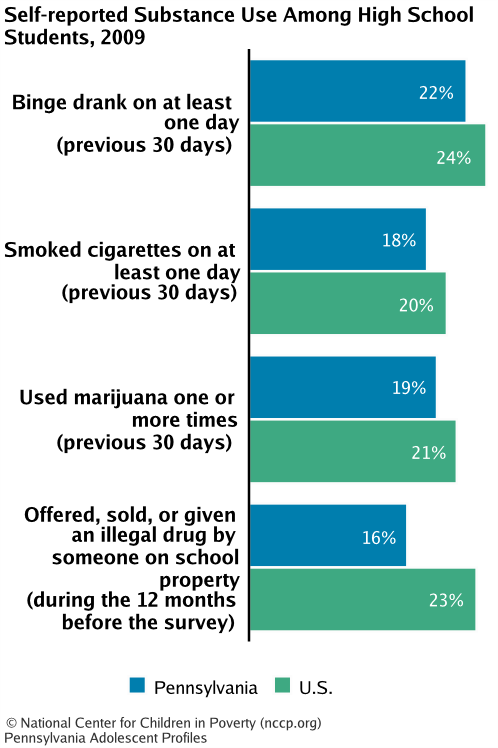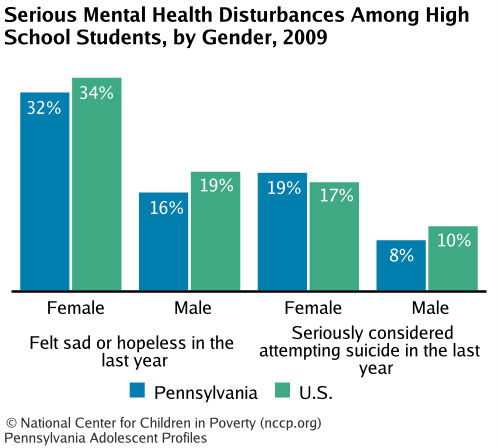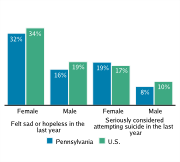| Health | Mental Health | Violence and Injury Prevention |
State Choices to Promote Access


Promotion, Prevention, and Early Intervention
- Have a public school health education curriculum that requires drug/alcohol prevention education [2006]2
- Have legislation or board of education policy that explicitly establishes and applies social and emotional learning standards [2010]3
Services in Schools
- Counseling for emotional or behavioral disorders [2006]4
- Crisis intervention for personal problems [2006]4
- Suicide prevention services [2006]5
Law and Legislation
- Allow minors to consent to outpatient mental health care [2010]6
- Allow minors to consent to care for drug or alcohol abuse [2010]7
State Choices to Promote Quality
Workforce Development
- Provide funding or staff development on emotional and mental health to health education teachers [2006]9
Self-reported mental health needs of youth in juvenile justice residential placement (not state-specific)[2003]10
68% Easily upset
61% Lost temper easily
61% Felt angry a lot
51% Had nervous or worried feelings keep you from doing things you want to do?
52% Felt lonely too much of the time
70% Had something very bad or terrifying happen to you
67% Seen someone severely injured or killed (in person)
Data Notes and Sources
Last Updated: June 1, 2011
These state profiles are part of the Improving the Odds for Adolescents project, which is supported by a generous grant from The Atlantic Philanthropies. Contact us with questions or to update your state profile.
- Centers for Disease Control and Prevention, Youth Risk Behavior Surveillance System (YRBSS). 2009. High School Youth Risk Behavior Survey, 2009. Accessed Aug. 10, 2010, from apps.nccd.cdc.gov/YouthOnline/App/Default.aspx.
- Centers for Disease Control and Prevention, State-Level School Health Policies and Practices. A State-by-State Summary from the School Health Policies and Programs Study 2006. Table 1.5. Accessed July 29, 2010, from www.cdc.gov/HealthyYouth/SHPPS/2006/summaries/pdf/State_Level_Summaries_SHPPS2006.pdf.
Centers for Disease Control and Prevention, State-Level School Health Policies and Practices. A State-by-State Summary from the School Health Policies and Programs Study 2006. Table 1.6. Accessed July 29, 2010, from www.cdc.gov/HealthyYouth/SHPPS/2006/summaries/pdf/State_Level_Summaries_SHPPS2006.pdf. - Data not available.
Palmer, Kara. 2010. A Study of Statewide Social and Emotional Learning Policy and Practices: Prepared for the Raikes Foundation. - Centers for Disease Control and Prevention. State-Level School Health Policies and Practices: A State-by-State Summary from the School Health Policies and Programs Study 2006. Table 3.2.2. Accessed Mar. 5, 2010, from www.cdc.gov/HealthyYouth/SHPPS/2006/summaries/pdf/State_Level_Summaries_SHPPS2006.pdf.
- Centers for Disease Control and Prevention, State-Level School Health Policies and Practices. A State-by-State Summary from the School Health Policies and Programs Study 2006. Table 3.3. Accessed July 29, 2010, from www.cdc.gov/HealthyYouth/SHPPS/2006/summaries/pdf/State_Level_Summaries_SHPPS2006.pdf.
- Only if 14 or older.
Many states generally allow emancipated minors, married minors, pregnant minors, minor parents, or other subgroups to consent for their own health care.
English, Abigail; Bass, Lindsay; Boyle, Alison Dame; Eshragh, Felicia. 2010. State Minor Consent Laws: A Summary, 3rd Edition. Center for Adolescent Health and the Law. - Many states generally allow emancipated minors, married minors, pregnant minors, minor parents, or other subgroups to consent for their own health care.
English, Abigail; Bass, Lindsay; Boyle, Alison Dame; Eshragh, Felicia. 2010. State Minor Consent Laws: A Summary, 3rd Edition. Center for Adolescent Health and the Law. - Centers for Disease Control and Prevention. State-Level School Health Policies and Practices: A State-by-State Summary from the School Health Policies and Programs Study 2006. Table 4.5. Accessed Mar. 5, 2010, from www.cdc.gov/HealthyYouth/SHPPS/2006/summaries/pdf/State_Level_Summaries_SHPPS2006.pdf.
- Centers for Disease Control and Prevention. State-Level School Health Policies and Practices: A State-by-State Summary from the School Health Policies and Programs Study 2006. Table 1.14. Accessed Mar. 5, 2010, from www.cdc.gov/HealthyYouth/SHPPS/2006/summaries/pdf/State_Level_Summaries_SHPPS2006.pdf.
- Sedlak, Andrea J.; McPherson, Carla S. 2010. Youth's Needs and Services: Findings from the Survey of Youth in Residential Placement, OJJDP Juvenile Justice Bulletin. Accessed July 19, 2010, from www.ncjrs.gov/pdffiles1/ojjdp/227728.pdf.


